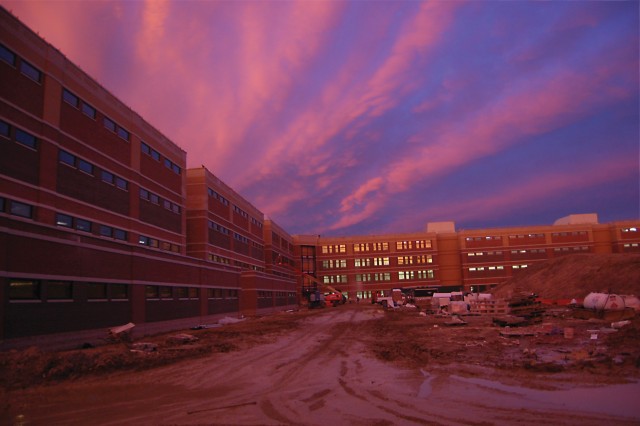Fort Lee, Va. (Feb. 12, 2009) -- If laid out on the ground it would stretch the length of five football fields. If filled with water, it would hold more than 18 million gallons of water. It is the Army Logistics University.
ALU, with a total cost of about $136 million, is a Base Realignment and Closure project scheduled for completion on Fort Lee, Va., in late April 2009.
Once completed, it will resemble an all-inclusive small-college campus situated on 46 acres near the Mahone Avenue gate and will be the single largest building on the installation with more than 300,000 square feet.
To give perspective to the size of the building, the White House has 55,000 square feet, an average Sam\'s Club is approximately 115,000 square feet and the nation's largest Wal-Mart Super Center, located in Albany, New York, is 260,000 square feet.
The contract for ALU was awarded July 2007 and the first pieces of steel were erected in early September 2007. In a period of 15 months, the university already has carpet and painted walls in some areas with more classrooms and projects being completed on a daily basis.
Once completed, ALU will assume responsibility for the logistics leader education currently taking place at the Quartermaster, Ordnance and Transportation Schools.
This means that over 200 courses currently being offered by five schools will be consolidated in one university.
"After the Army Logistics University is stood up, an Army leader in the logistics field will continue to come back to Fort Lee throughout their career to gain additional skills that will prepare them for their next level of responsibility," said Col. Shelley Richardson, ALMC school commandant.
The biggest gains will come in the number of students and quality of instruction the new facility will be able to offer logisticians from all over the world.
Equipped with video teleconferencing capabilities, a simulation center and library, ALU will have the ability to train more than 2,300 military and Civilian students from 60 different foreign countries daily.
This equates to approximately 19,000 students taking resident courses through the university annually. In comparison, Virginia Commonwealth University in Richmond supports approximately 22,000 students annually.
Although the transformation will be tremendous from a logistical standpoint, the move will go almost unnoticed by the student population.
"The plan is for the integration to be a transparent transformation to the students," said Peter Adler, ALU strategic planner. "Most classes will end and (the next class) will pick up at the new location. The move will happen over the weekend for those classes that have to move midcourse so there will be as little impact on the students as possible."
To support the student load, the university will be led by a general officer responsible for a staff and faculty of more than 450. The university itself will be comprised of four distinct colleges, each with unique responsibilities. T
he four colleges are the Army Logistics Management College, the Logistics Leader College, the Technical Logistics College and the Logistics Noncommissioned Officer Academy.
SIMULATION CENTER
The simulation center is the equivalent to a giant combat-scenario video game that allows users to input variables and circumstances that Soldiers would have to deal with in real-world operations. Based on the students' input, the center will be able to provide immediate feedback on how their decisions would effect the situation. Not to over simplify the function of the simulation center, but it could be compared to a very advanced Sony Playstation or computer simulation game where the user is responsible for making decisions that will affect the people in the community, said Albert Cruz, BRAC project manager.
"The hardest part of war is making decisions," said William Moore, Combined Arms Support Command deputy to the commander. "If we can simulate the stresses and evaluate our Soldiers' decisions here, at a fraction of the cost, it can dramatically increase their ability to make the right decision at the right time."
LIBRARY
The ALU library will be comprised of two main elements. The first element will be the logistics research element that combines collections from the ALMC, TC&S and the OC&S. Here students will be able to move freely and conduct research in an area four times larger than the current ALMC library.
The second element, a great benefit for both the students and community, will be the establishment of Fort Lee's only community library.
"The community library section will be a great benefit for residents from Fort Lee and members of the community," said Richardson. "This (Family, Morale, Welfare and Recreation) section will provide popular and current reading materials for visitors."


Social Sharing